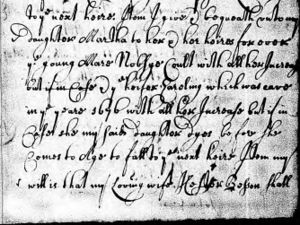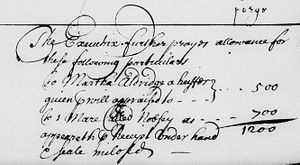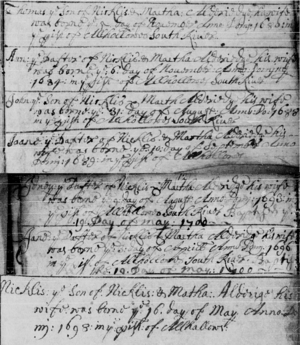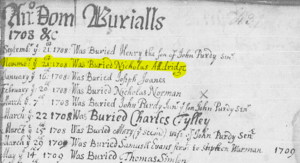m (→Immigration: Fix links.) |
|||
| (12 intermediate revisions by the same user not shown) | |||
| Line 19: | Line 19: | ||
We can assume that our Nicholas was born before about 1656, since he was able to receive a proprietary land grant in 1680, and serve in a colonial militia in 1677. Within the parameters of a Nicholas Aldridge born in England between 1637 and 1657, only one Nicholas Aldridge appears in a search of the birth registers available on FamilySearch, the one asserted above, christened 28 December 1653 in Wellow, Hampshire. A second appears if I push the search back to 1627, christened 15 December 1633 at St. Margaret's, Westminster, Middlesex, the son of Thomas Aldridge. But how do we know these records are complete? How do we know Nicholas was born in England and not in Scotland, Wales, or anywhere else? We do not. Unless there is some record connecting Nicholas Aldridge in Maryland back to a specific location in England or wherever, I will not make an assumption. | We can assume that our Nicholas was born before about 1656, since he was able to receive a proprietary land grant in 1680, and serve in a colonial militia in 1677. Within the parameters of a Nicholas Aldridge born in England between 1637 and 1657, only one Nicholas Aldridge appears in a search of the birth registers available on FamilySearch, the one asserted above, christened 28 December 1653 in Wellow, Hampshire. A second appears if I push the search back to 1627, christened 15 December 1633 at St. Margaret's, Westminster, Middlesex, the son of Thomas Aldridge. But how do we know these records are complete? How do we know Nicholas was born in England and not in Scotland, Wales, or anywhere else? We do not. Unless there is some record connecting Nicholas Aldridge in Maryland back to a specific location in England or wherever, I will not make an assumption. | ||
Cousin '''Susan94543''' on FamilySearch has identified [[Aldridge of Wellow#Court cases|several court cases]] in Wellow that appear to place the Nicholas Aldridge (b. 1653) of the above record still in Wellow in 1682 and 1686, placing the identification of the 1653 christening record as our Nicholas in extreme doubt. | |||
== Immigration == | |||
The ''New Early Settlers of Maryland'' identifies Nicholas Aldridge's immigration with this record: | |||
: '''Aldridge, Oldridge, Nicholas.''' 18:33. Transported by 1674. Transcript: WC4:215. MSA SC 4341.<ref>''The New Settlers of Maryland''. https://msa.maryland.gov/msa/speccol/sc4300/sc4341/html/intro.html</ref> | |||
A transcript of the first referenced record<ref>Patent Record 18:33, 1672‒1675, [https://msa.maryland.gov/megafile/msa/stagserm/sm1/sm2/000000/000021/pdf/mdsa_sm2_21.pdf MSA SR 7359].</ref> is as follows: | |||
: June the 4th 1674. Came Robert Franklin of Ann Arundell County Gent and proved Right to Two hundred acres of land for Transporting '''Gustavus White''', '''Nicholas Oldridge''', '''Wililam Webb''', and '''Thomas King''' into this province to inhabit. Warrant then issued in the name of the said Robert Franklin for two hundred acres of land due to him for the consideration of aforesaid. Cert. return the 4th of Sept. next. | |||
The second record<ref>Warrant Record WC4:215, i, 1681‒1685, [https://msa.maryland.gov/megafile/msa/stagserm/sm200/sm230/000000/000001/pdf/mdsa_sm230_1.pdf MSA SC 4341].</ref>, dated 1682 shows: | |||
: The names of such persons that have been brought in by Benjamin Lawerence (vizt.): | |||
: '''Gustavus White''', '''Nicholas Aldridge''', '''William Webb''', '''Thomas King''', Benjamin Lawrence, Eleanor Stuart | |||
: Giles Stawby, Thomas Grimfield, William Popjoy, Elizabeth Croom, Martha Croom | |||
: George Croom, Joice Croom, Thos. Bonifin, Mathew Currin, Katharine Paine | |||
: Mary Ano, William Wheeler, Lewis Lott, Richard Lawr, Thomas Lawrence | |||
: 17 August 1682. The above mentioned rights being twenty one was prooved by Benjamin Lawrence the Transporter. | |||
: Before me Nicholas Sewall. | |||
Note the first four names of this record are the same people as the 1674 record. Evidently Benjamin Lawrence purchased these rights, included Nicholas's. This parity confirms that the 1674 record does refer to Nicholas ''Aldridge'', despite that record spelling it ''Oldridge''. So we have a confirmed record of Nicholas Aldridge in Maryland as early as 1674. | |||
== Militia service and land patent == | == Militia service and land patent == | ||
The earliest record | The next earliest record I have found of Nicholas Aldridge in Maryland is an October or November 1678 payment to him by the Maryland General Assembly, apparently for militia service in an expedition against the Nanticoke Indians: | ||
: An Act for payment and assessing the Publick Charges of this Province | : An Act for payment and assessing the Publick Charges of this Province | ||
| Line 29: | Line 52: | ||
: To Nicholas Aldridge, 50 lbs. tobacco.<ref>''Archives of Maryland'', Volume 7: Proceedings and Acts of the General Assembly, October 1678–November 1683, 87–104, at 97 ([https://msa.maryland.gov/megafile/msa/speccol/sc2900/sc2908/000001/000007/html/am7--97.html Archives of Maryland Online]).</ref> | : To Nicholas Aldridge, 50 lbs. tobacco.<ref>''Archives of Maryland'', Volume 7: Proceedings and Acts of the General Assembly, October 1678–November 1683, 87–104, at 97 ([https://msa.maryland.gov/megafile/msa/speccol/sc2900/sc2908/000001/000007/html/am7--97.html Archives of Maryland Online]).</ref> | ||
This payment would indicate that Nicholas had been in Maryland at least as early as 1677, and perhaps earlier. | This payment would indicate that Nicholas had been in Maryland at least as early as 1677, and perhaps earlier. The Nanticoke Indians took up arms against against the European colonists in 1677–1678.<ref>Gray Dove Trading, "The Nanticoke People." https://web.archive.org/web/20060220191454/http://www.graydovetrading.com/Nanticoke.html</ref> | ||
Nicholas Aldridge entered a land patent in Anne Arundel County, Maryland, of 300 acres on the south side of the [[wikipedia:Magothy River|Magothy River]], surveyed for him on 20 August 1680. The grant was issued by [[wikipedia:Charles Calvert, 3rd Baron Baltimore|Charles Calvert, Lord Baltimore]] on 11 July 1681, a tract called "Aldridge's Beginning." | Nicholas Aldridge entered a land patent in Anne Arundel County, Maryland, of 300 acres on the south side of the [[wikipedia:Magothy River|Magothy River]], surveyed for him on 20 August 1680. The grant was issued by [[wikipedia:Charles Calvert, 3rd Baron Baltimore|Charles Calvert, Lord Baltimore]] on 11 July 1681, a tract called "Aldridge's Beginning." | ||
| Line 75: | Line 98: | ||
Nicholas Aldridge died in November 1708 in All Hallows' Parish, Anne Arundel County, Maryland, and was buried 21 November 1708 in the churchyard. His grave is no longer marked. Nicholas was likely a man in his forties or fifties when he died, which was a ripe age for a Maryland colonist in that time. | Nicholas Aldridge died in November 1708 in All Hallows' Parish, Anne Arundel County, Maryland, and was buried 21 November 1708 in the churchyard. His grave is no longer marked. Nicholas was likely a man in his forties or fifties when he died, which was a ripe age for a Maryland colonist in that time. | ||
[[File:Nicholas Aldridge Burial.png|thumb|center]] | [[File:Nicholas Aldridge Burial.png|thumb|center]] | ||
There are actually two All Hallows' Parish cemeteries, at two different locations of the All Hallows' Church, one at parish's original location at the "Brick Church" in Edgewater, and the other at the parish's chapel-of-ease in Davidsonville: | |||
: The Church of England was officially established in the Colony of Maryland In 1692 by King William and Queen Mary, who chartered 30 parishes, one of which was All Hallows, South River. However, our earliest Parish records date back to March 1, 1669, noting the first recorded baptism at All Hallows.... | |||
: In October of 1729, the General Assembly of Maryland assessed a tax of 20,000 pounds of tobacco to build “The Brick Church.” The building’s Interior was altered extensively during the 19th century according to needs and tastes of the time.... | |||
: To lessen the travel distance for parishioners living on the western side of the Parish, construction of a chapel-of-ease in Davidsonville was begun in 1860. Delayed by the Civil War, it was completed in 1865.<ref>All Hallows Parish. "[https://allhallowsparish.org/who-we-are/history/ The History of All Hallows Parish]" (accessed 19 July 2024).</ref> | |||
Wikipedia offers this description of the cemetery at the "Brick Church", which seems to confirm it as the likely burial place of Nicholas and Martha Aldridge: | |||
: The ancient cemetery, shaded by a grove of oak trees, surrounds the church. It contains the graves of many local families. One is Provincial Justice, Deputy-Governor and Lord High Sheriff of Anne Arundel Colonel William Burgess (1622–1686), who donated 100 acres of his lands for the establishment of Londontowne.<ref>"[[wikipedia:All Hallows Parish (South River, Maryland)|All Hallows Parish (South River, Maryland)]]" on Wikipedia, citing Earl Arnett, Robert Brugger, and Edward Papenfuse, ''Maryland: A New Guide to the Old Line State'' (Baltimore: Johns Hopkins University Press, 1976) (accessed 19 July 2024).</ref> | |||
On Find a Grave, Dennis York listed Nicholas and Hannah Aldridge in the wrong cemetery, at Davidsonville. I submitted corrections to move their memorials to the correct location, which were accepted. | |||
== DNA evidence == | == DNA evidence == | ||
Latest revision as of 16:12, 14 August 2025
| Name: | Nicholas Aldridge (or Alldredge) |
| Born: | before 1660 probably England |
| Died: | about 21 November 1708 (buried 21 November) All Hallows' Parish, Anne Arundel County, Maryland |
| Buried: | All Hallows' Churchyard (Brick Church), Anne Arundel County, Maryland (grave now unmarked) |
| Married: | Martha Besson before 1680, probably in Anne Arundel County, Maryland |
| Children: | Thomas Aldridge, Nicholas Aldridge (b. 1698), William Alldredge (b. 1702) |
Overview
Nicholas Aldridge is the immigrant ancestor of our Aldridge family. He arrived in Anne Arundel County, Maryland, as early as 1677, receiving a land patent from Lord Baltimore in 1681.[1] Like the other elements in my Aldridge-Alldredge tree, Nicholas Aldridge is the subject of a lot of extravagant and poorly supported claims. On this page, I will document what we know for certain, and do my best to distinguish fact from speculation.
Name
There is evidence from records that Nicholas's son William and at least two branches of his descendants (William b. 1729 and Nathan) spelled their surname Alldredge. Of Nicholas's other descendants, his oldest son Thomas's family appears to have kept the spelling Aldridge. Traditionally, Nicholas Aldridge's name has been spelled Aldridge by Memory Aldridge Lester and other researchers. For now, I will stand by this tradition.
Ancestry and birth
It is widely asserted online that Nicholas Aldridge was christened 28 December 1653 in Wellow Parish, Wiltshire, England, the son of Nicholas Aldridge. There was indeed a Nicholas Aldridge born near that date, in that place, to that father, as shown by English parish records; but I have seen no definitive documentation to convince me that this is our Nicholas Aldridge, and at least some to make me seriously question it.
We can assume that our Nicholas was born before about 1656, since he was able to receive a proprietary land grant in 1680, and serve in a colonial militia in 1677. Within the parameters of a Nicholas Aldridge born in England between 1637 and 1657, only one Nicholas Aldridge appears in a search of the birth registers available on FamilySearch, the one asserted above, christened 28 December 1653 in Wellow, Hampshire. A second appears if I push the search back to 1627, christened 15 December 1633 at St. Margaret's, Westminster, Middlesex, the son of Thomas Aldridge. But how do we know these records are complete? How do we know Nicholas was born in England and not in Scotland, Wales, or anywhere else? We do not. Unless there is some record connecting Nicholas Aldridge in Maryland back to a specific location in England or wherever, I will not make an assumption.
Cousin Susan94543 on FamilySearch has identified several court cases in Wellow that appear to place the Nicholas Aldridge (b. 1653) of the above record still in Wellow in 1682 and 1686, placing the identification of the 1653 christening record as our Nicholas in extreme doubt.
Immigration
The New Early Settlers of Maryland identifies Nicholas Aldridge's immigration with this record:
- Aldridge, Oldridge, Nicholas. 18:33. Transported by 1674. Transcript: WC4:215. MSA SC 4341.[2]
A transcript of the first referenced record[3] is as follows:
- June the 4th 1674. Came Robert Franklin of Ann Arundell County Gent and proved Right to Two hundred acres of land for Transporting Gustavus White, Nicholas Oldridge, Wililam Webb, and Thomas King into this province to inhabit. Warrant then issued in the name of the said Robert Franklin for two hundred acres of land due to him for the consideration of aforesaid. Cert. return the 4th of Sept. next.
The second record[4], dated 1682 shows:
- The names of such persons that have been brought in by Benjamin Lawerence (vizt.):
- Gustavus White, Nicholas Aldridge, William Webb, Thomas King, Benjamin Lawrence, Eleanor Stuart
- Giles Stawby, Thomas Grimfield, William Popjoy, Elizabeth Croom, Martha Croom
- George Croom, Joice Croom, Thos. Bonifin, Mathew Currin, Katharine Paine
- Mary Ano, William Wheeler, Lewis Lott, Richard Lawr, Thomas Lawrence
- 17 August 1682. The above mentioned rights being twenty one was prooved by Benjamin Lawrence the Transporter.
- Before me Nicholas Sewall.
Note the first four names of this record are the same people as the 1674 record. Evidently Benjamin Lawrence purchased these rights, included Nicholas's. This parity confirms that the 1674 record does refer to Nicholas Aldridge, despite that record spelling it Oldridge. So we have a confirmed record of Nicholas Aldridge in Maryland as early as 1674.
Militia service and land patent
The next earliest record I have found of Nicholas Aldridge in Maryland is an October or November 1678 payment to him by the Maryland General Assembly, apparently for militia service in an expedition against the Nanticoke Indians:
- An Act for payment and assessing the Publick Charges of this Province
- Whereas There hath been Eight hundred twenty five thousand Nyne hundred Seventy Nyne pounds (825,979 lbs.) of Tobacco Expended, layd out & disbursed by severall of the Inhabitants of this Province in the late Expedicion against the Nanticoke Indians and other, the necessary Charges of this Province which hath been Examined, stated and allowed by the upper and lower houses of this present Generall Assembly To the intent therefore That the same may bee satisfyed and payd to those persons to whom the same is due ...
- To Nicholas Aldridge, 50 lbs. tobacco.[5]
This payment would indicate that Nicholas had been in Maryland at least as early as 1677, and perhaps earlier. The Nanticoke Indians took up arms against against the European colonists in 1677–1678.[6]
Nicholas Aldridge entered a land patent in Anne Arundel County, Maryland, of 300 acres on the south side of the Magothy River, surveyed for him on 20 August 1680. The grant was issued by Charles Calvert, Lord Baltimore on 11 July 1681, a tract called "Aldridge's Beginning."
Marriage and spouse


Nicholas Aldridge marriage a woman named Martha, probably about 1679–1680. Their oldest child, Thomas Aldridge, was born 5 November 1680.
I have found a fairly strong case for the assertion that Nicholas's wife was Martha Besson, daughter of Thomas Besson. Two records in particular demonstrate this case:[7]
- In the will of Thomas Besson, he names his daughter Martha, leaving to her a mare named Nobsey and a heifer named Eareling:
- Item. I give and bequeath unto my daughter Martha, to her and her heirs forever, the young Mare Nobsye Coult with all her Increase,
but if in caseand the heifer Eareling which was cavd in the yeare 1676 with all her Increase but if in case she my said daughter dyes before she comes to Age to fall to the next heir.[8]
- Item. I give and bequeath unto my daughter Martha, to her and her heirs forever, the young Mare Nobsye Coult with all her Increase,
- In the account of Besson's executrix, Nicholas Aldridge is paid a sum of money. The last item in the account contains a petition for an allowance for the heifer and mare due to Martha Aldridge:
- The Executrix further prays allowance these following particulars: To Martha Aldridge a heiffer given by will appraised to 500. To 1 Mare called Nobsey as 700.[9]
This indicates that Martha Aldridge is the daughter of Thomas Besson, the same daughter Martha to whom he bequeathed the mare Nobsey and heifer Eareling.
Children

These children of Nicholas Aldridge and Martha Besson are documented by parish birth records:[10]
- Thomas Aldridge, born 5 November 1680, married Elizabeth Purdy on 15 July 1703.
- Ann Aldridge, born 6 November 1684, married Richard Richeson in 1707.
- John Aldridge, born 31 August 1688, married Susannah Jones on 1 April 1719.
- Joane Aldridge, born 10 September 1689.
- Sendy Aldridge, born 9 August 1693, baptized 19 May 1700 [the name is difficult to read].
- Jane Aldridge, born 3 April 1696, baptized 19 May 1700.
- Nicholas Aldridge, born 16 May 1698.
- William Aldridge, born 30 October 1700. Buried 26 September 1702.
- William Aldridge, born 13 Mar 1702, baptized 11 April 1703.
- James Aldridge, born 1 July 1706, married Mary Gassaway.
Nicholas Aldridge did indeed have two sons named William, one born after another, and by the dates, it appears he even named the second one William before the first one passed away. Did he, knowing his first son William was sick and would die, consciously give the name again to his next son? Is it possible the second William did not receive the name until his baptism, after the death of the first William? It is difficult to guess exactly what went on here, but the records are clear.
-
All Hallows' Parish register showing birth of William Aldridge "I" (1700).
-
All Hallows' Parish register showing baptism of William Aldridge "I" (1702).
-
All Hallows' Parish register showing burial of William Aldridge "I" (1702).
-
All Hallows' Parish register showing the birth and baptism of William Aldridge "II" (1702).
-
All Hallows' Parish register showing the birth of James Aldridge (1706).
Death
Nicholas Aldridge died in November 1708 in All Hallows' Parish, Anne Arundel County, Maryland, and was buried 21 November 1708 in the churchyard. His grave is no longer marked. Nicholas was likely a man in his forties or fifties when he died, which was a ripe age for a Maryland colonist in that time.

There are actually two All Hallows' Parish cemeteries, at two different locations of the All Hallows' Church, one at parish's original location at the "Brick Church" in Edgewater, and the other at the parish's chapel-of-ease in Davidsonville:
- The Church of England was officially established in the Colony of Maryland In 1692 by King William and Queen Mary, who chartered 30 parishes, one of which was All Hallows, South River. However, our earliest Parish records date back to March 1, 1669, noting the first recorded baptism at All Hallows....
- In October of 1729, the General Assembly of Maryland assessed a tax of 20,000 pounds of tobacco to build “The Brick Church.” The building’s Interior was altered extensively during the 19th century according to needs and tastes of the time....
- To lessen the travel distance for parishioners living on the western side of the Parish, construction of a chapel-of-ease in Davidsonville was begun in 1860. Delayed by the Civil War, it was completed in 1865.[11]
Wikipedia offers this description of the cemetery at the "Brick Church", which seems to confirm it as the likely burial place of Nicholas and Martha Aldridge:
- The ancient cemetery, shaded by a grove of oak trees, surrounds the church. It contains the graves of many local families. One is Provincial Justice, Deputy-Governor and Lord High Sheriff of Anne Arundel Colonel William Burgess (1622–1686), who donated 100 acres of his lands for the establishment of Londontowne.[12]
On Find a Grave, Dennis York listed Nicholas and Hannah Aldridge in the wrong cemetery, at Davidsonville. I submitted corrections to move their memorials to the correct location, which were accepted.
DNA evidence
Six patrilineal, male-line descendants of Nicholas Aldridge have tested their Y-DNA at the Aldridge DNA Project, one from his oldest son Thomas, one from his son Nicholas, and four from his son William (b. 1702). The DNA of all five men matches one another, and is classified as haplogroup R-FTC89975, a subclade of R-U106 > R-Z154. William's descendants form the haplogroup R-FTB32679, an additional subclade of R-FTC89975.
References
- ↑ Memory Aldridge Lester, Alldredge-Aldridge-Bracken-Nesmith Families and Their Kin (Chapel Hill, N.C.: privately printed, 1957), available on Ancestry, Internet Archive, and FamilySearch, 5 (Ancestry, Internet Archive, [www.familysearch.org/library/books/idviewer/541095/16 FamilySearch]); Franklin Rudolph Aldridge, Aldridge Records, vol. 2 (Nashville: self-published, 1975), 22 (Ancestry, [hwww.familysearch.org/library/books/idviewer/34303/26 FamilySearch]); Maryland Historical Magazine, vol. 26 (1931), page 273 (Internet Archive). F. R. Aldridge offers extensive records of Nicholas Aldridge's family in Maryland.
- ↑ The New Settlers of Maryland. https://msa.maryland.gov/msa/speccol/sc4300/sc4341/html/intro.html
- ↑ Patent Record 18:33, 1672‒1675, MSA SR 7359.
- ↑ Warrant Record WC4:215, i, 1681‒1685, MSA SC 4341.
- ↑ Archives of Maryland, Volume 7: Proceedings and Acts of the General Assembly, October 1678–November 1683, 87–104, at 97 (Archives of Maryland Online).
- ↑ Gray Dove Trading, "The Nanticoke People." https://web.archive.org/web/20060220191454/http://www.graydovetrading.com/Nanticoke.html
- ↑ Fredric Z. Saunders' page on Thomas Besson is very well researched and very helpful, especially in documenting and locating the necessary sources. Fredric Z. Saunders, "Thomas Besson," http://fzsaunders.com/besson.html (revised 27 Jan 2021, retrieved 13 Jul 2023).
- ↑ Ancestry.com, Maryland, U.S., Wills and Probate Records, 1635-1777, Wills, Vol 4-10 (1670, 1676-1679, 1682-1700) (Ancestry).
- ↑ Maryland, Prerogative Court, Inventories of accounts and estates, volume 7, pages 125–127, at 127 (FHL Film 12919, Image Group (DGS) 7737555, Image 679, FamilySearch).
- ↑ This reading is aided by the transcriptions of F. R. Aldridge, Aldridge Records, vol. 2, 25–26, and Lester, 5.
- ↑ All Hallows Parish. "The History of All Hallows Parish" (accessed 19 July 2024).
- ↑ "All Hallows Parish (South River, Maryland)" on Wikipedia, citing Earl Arnett, Robert Brugger, and Edward Papenfuse, Maryland: A New Guide to the Old Line State (Baltimore: Johns Hopkins University Press, 1976) (accessed 19 July 2024).




